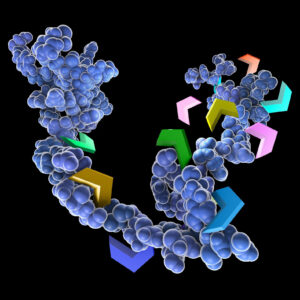
Tryptic digestion of samples and subsequent analysis by mass spectrometry is a popular technique for the identification of proteins typically those related to interaction partners or biomarkers characterization. This powerful tool can also be used for less traditional experimental designs. Three examples are:
Mahowald, M. et al. Characterizing a model human gut microbiota composed of members of its two dominant bacterial phyla. (2009) PNAS, 106, 5859-64.
Overview: The human distal gut microbial community is typically dominated by two bacterial phyla, the Firmicutes and the Bacteriodetes. Little is known about the factors that govern the interactions between their members. The interactions between two primary members ( E.rectale and B. thetaiomicron) from each group were charterized by performing whole genome transcriptional profiling and mass spectrometry of proteins (by tryptic digestion) of each species after colonization of gnotobiotic mice with each organism alone or in combination under three dietary conditions.
Budzik, J. et al. (2009) Intramolecular amide bonds stabilize pili on the surface of bacilli. PNAS 106, 19992–7.
Overview: BcpA is a major pilin subunit of Bacillus cereus. Pili are known to resistant to proteases. It is this factor that was used to examine the contribution of intermolecular amide bonds toward pilus structure and function. Pili assembled with wild type BcpA were resistant to trypsin treatment, which was used as an indicator of structural integrity of these fibers. A series of BcpA variants with alkaline substitutions were digested with trypsin, viewed by immunogold labeling and electron microscopy to determine their integrity when compared to the wild type.
Ranjith-Kumar, C-T. et al. (2009) Agonist and Antagonist Recognition of RIG-I, a Cytoplasmic Innate Immunity Receptor. J. Biol. Chem. 284, 1155–65.
Overview: Viral RNAs can bind to a subset of several innate immunity receptors such as RIG-I (retinoic acid protein). A number of RNA ligands were found to serve as agonists and also antagonists for RIG-I. Reversible cross-linking peptide fingerprinting was used to map antagonist binding to RIG-I. RNAs were cross linked to NHS –succimidyl ester-modified resin. RIG-I was cross linked to the bound RNA. Tryptic digestion was used to map the regions of RIG-I which interacted with the bound RNA.
Are you looking for proteases to use in your research?
Explore our portfolio of proteases today.
